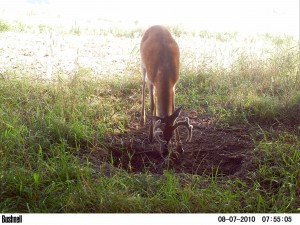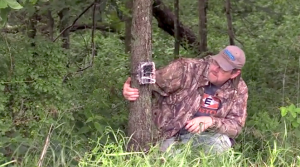The best deer mineral program is one that features variety and consistency. Here are some deer mineral recipe tips and tactics to get your whitetails as healthy as they can be.

Intake is a vital factor when formulating any mineral or protein supplement program for the healthy of whitetail deer, and here’s why.
Have you ever traveled through western Kansas? It’s a bountiful area that produces wheat, corn and beef cattle that feed thousands of people around the world. In its own way, western Kansas is quite beautiful, that is, of course, unless you like a lot of trees.
Western Kansas is also flat, and when I say flat, I don’t mean kind of flat. I’m talking smashed with a giant skillet flat. If you were looking for good descriptive words, vast and expansive would come to mind.
If you stand in the middle of Highway 400 just west of Dodge City and look out at the horizon, you can get a good understanding of why people once thought the Earth was flat. After all, it sure looks that way. Of course, we now know the Earth isn’t flat, but it wasn’t a popular belief until science and ocean navigation proved it.

There are many other examples of popular beliefs being dramatically changed through scientific discovery. Even in the “deer world,” we are continuously finding that what we thought was fact one day is completely disproved the next.
For example, for many years, it was commonly accepted that adult bucks did all or most of the breeding. However, while recent studies have shown that adult bucks indeed do much of the breeding, bucks as young as 1 1/2 also are involved in the rut game.
For several years now, I have been formulating free choice minerals for wild deer. When formulating free choice minerals, or any feed product for that matter, the vital elements include the ingredients used along with the percentage of those ingredients and the resulting percentage of actual nutrients (i.e. calcium, phosphorus, zinc, etc.). But there is another important factor that’s nearly always overlooked by both people using free choice minerals and those putting these products together. This final and vital piece of the puzzle is daily intake.
Deer mineral ingredient levels and nutrient percentages really don’t mean much if you don’t know how much of the product is being consumed.
Use Deer Mineral Products that Make Sense
Free choice minerals are probably one of the most difficult products where you can get a good sense of intake. To my knowledge, there is little to no research on the subject as it pertains to deer. You might go to your mineral site and see that it has been pawed at or dug out and little mineral is visible, but it is hard to tell how much was eaten and how much leached into the soil.
This past summer, I was developing a new deer mineral product and was constantly frustrated by the fact that I really didn’t know what expected intake would be. The most common intake claim by deer products on the market is 1 to 2 ounces per head per day or 1/16 to 1/8 of a pound. I struggled with that, because many cattle minerals have a known intake consumption of 2 to 4 ounces per head per day.
Because intake is typically relative to body weight, one would think that if a cow weighing 1,400 pounds was eating 2 to 4 ounces of mineral, then a deer weighing 200 pounds should eat only between 0.28 to 0.57 ounces, not 1 to 2 ounces. Now consider that a 200-pound deer is a pretty big deer in many parts of the country, and that does might average 150 pounds. That means their expected consumption should be 0.21 to 0.42 ounces per head, per day.
Of course, while mulling this over in my Excel spreadsheet, I was making a lot of assumptions, so I decided to conduct a research project on one of my farms to see if I could come up with a number based on real data.
WATCH: Where to Place Minerals for the Best Results
The Importance of Knowing Intake As I previously mentioned, intake is a vital factor when formulating a mineral or protein supplement or complete feed. Nutrient levels mean virtually nothing if you do not at least have an approximate idea of how much of a product the deer are consuming.
For example, research has shown that a buck needs about an 18 percent protein diet during the antler-growing cycle to maximize antler growth. Deer will consume anywhere between 1 to 5 percent of their body weight each day, depending on the time of year, with winter consumption being on the low end of the scale and summer consumption being on the higher end.
So, if we take a 200-pound buck and say that he’s eating 4 percent of his body weight each day, then this equates to 8 pounds of total daily food consumption. Now, back to the 18 percent protein. If a buck consumes 8 pounds of total food per day, then in order to hit an 18 percent protein level in his diet, he would need to consume 1.44 pounds of protein.
Now, consider two different protein supplements, one with a level of 28 percent protein and one at 22 percent protein. In order to hit the 1.44 pounds of protein, the buck would need to consume 5.1 pounds of the 28 percent product or 6.5 pounds of the 22 percent product. If the buck consumes only 3 pounds of the 28 percent protein product but eats 5 pounds of the 22 percent product, he is actually getting more protein from the 22 percent product than the 28 percent product. Most folks would simply look at the tag and see that one product is 28 percent and the other 22 percent and just assume that the deer is getting more protein from the 28 percent protein product.
Even though we used protein in this example, the same is true for nutrients in a mineral supplement. If one mineral supplement has 5 percent calcium and another has 7 percent calcium, but the deer consumes twice the amount of the 5 percent product, then the deer is actually getting more calcium than it would be getting from the 7 percent product. This is why knowing your intake is so important for your mineral program.

Factors Affecting Mineral Intake Deer are very finicky when it comes to eating, especially when it is supplemental products offered to wild deer. Any one of a hundred things can influence how often a deer will use a supplemental mineral and how much it will consume. The form it is in (block versus granular), location of the mineral site, soil type, salt content, competition, aggression of other deer, how long the site has been established and a host of other factors all affect how much a mineral site will be used.
Over the years, with the use of thousands of trail camera photos and a lot of trial and error, I have figured out a few factors that influence mineral consumption both positively and negatively. I group these factors into two categories — non-nutritional and nutritional factors. To begin with the non-nutritional category, location is critical. Deer prefer mineral sites that are in cover as opposed to out in the open.
When creating sites, I try to find heavily used trails or trail crossings somewhere in cover (brush or timber) and create the site just off that trail or trail crossing. But this does not guarantee that deer will use the site. I have used the same product literally 100 yards apart from each other, and the deer heavily used one site but not the other. So when I am creating new sites, I try several locations and replenish the ones that receive continued use while abandoning the sites with little or no use. Basically, the deer will tell you where they like to eat.
I have also found that unless there are major changes in the vicinity of the site (i.e. logging, flooding), a mineral site will receive increased usage with each progressive year. Research has shown that after a site is used, it will often become a part of the feeding and movement pattern. Also, fawns will learn mineral site areas from their mothers and will return to sites even after they are weaned.
Granular minerals seem to work better than blocks, as most of the usage of blocks occurs in the surrounding dirt as the minerals leach into the soil. Along those same lines, deer will more readily utilize minerals that are ground applied than offered in a man-made feeder. Increased aggression by certain deer (usually adult does) that “guard” the site will decrease the number of deer utilizing that particular location. Because of this, I normally recommend at least one site per 40 acres to minimize site competition, with more sites needed in areas with higher deer density.
One final deer mineral site consideration for non-nutritional factors is soil type. I have found that mineral sites located in sandy areas are utilized less than mineral sites in heavier soils. I cannot definitely answer why this is, but I would theorize that it has to do with excessive leaching in sandy soils or possibly even the gritty nature of sand.
Nutritional consumption factors revolve around the attractant agent used in the product. Salt is the most common attractant used in mineral supplements. Attraction to salt is caused by the balance of potassium and sodium in the deer’s body. Potassium and sodium must maintain a balance at a cellular level, and since most green, growing vegetation is much higher in potassium than sodium, deer become “salt hungry” during the spring and summer as their bodies crave more sodium.
However, salt can also be an intake limiter for the very same reason and is often used in livestock minerals to limit intake. So a product that is very high in salt will likely have less total consumption than a product lower in salt. However, there must be enough salt in the product for the deer to be attracted to it.
As you can see, getting the right salt level in a mineral can be tricky. As fall approaches, vegetation begins to mature and drop in potassium. Salt becomes less of an attractant, which means that in order to get continued mineral consumption, a different type of attractant must be used.
WATCH: 3 Things You’re Doing Wrong with Your Mineral Sites
The Deer Mineral Research Project
The methodology I used in my research project was relatively simple. The test involved comparing a beginning mineral weight to an ending weight. But I also had to know how many deer, on average, were using the site each day and if it was simply the same deer returning to site multiple times a day. Also, I had to make sure I didn’t lose any mineral to leaching.
I began the project by placing black plastic feeding pans at my oldest and most frequented deer mineral sites. I buried them partially in the ground in an attempt to minimize the negative effect of using a container versus the normal method of direct ground application. Also, slightly burying the pan helped to ensure the mineral would not be spilled.

I then placed cameras at each one of the sites to monitor usage. Before beginning the test, I allowed 30 days to let the deer get used to the feeding pan and then began the test after I started seeing consistent usage on my trail cameras.
When I felt that the deer were using the site normally again, I removed all content from each pan and replaced it with exactly 5 pounds of mineral at each site. I then allowed the deer to use the sites for seven days, at which time I removed the remaining contents from the pan and weighed it in order to get a total usage. At the same time, I reviewed the cameras located at each spot to identify how many deer were using the site each day.
While I could identify many of the deer that used the sight daily, some did not use the site each day, and some could not be definitely identified as a daily user. Therefore, I took the total number of deer that used the site over a seven-day period and divided it by seven days to reach an approximate number of deer using the site each day. I replicated the test on three different farms to help alleviate variables, at least to a certain degree. The test was conducted in July.
Result Farm A had an average number of 11 adult deer using the site on a daily basis. At least eight were using the site each day, including three yearling does, two adult does, two yearling bucks and one 3-year-old buck. The amount of mineral that remained in the feeding pan was 3.6 pounds or 57.75 ounces. This would equate to an average ounce-per-head-per-day intake of .29 ounces.
Farm B had a total of eight adult deer using the deer mineral site, five of which used the site on a daily basis. The feeding pan had a total of 4.27 pounds, or 68.24 ounces, of mineral remaining. This would equate to a .21 ounce-per-head-per-day intake.
The third site on Farm C was discarded due to a camera failure.
WATCH: Where Do Bucks Go After Summer?
Discussion It would appear that, based on the test results, intake of a free choice deer mineral is substantially lower than what is commonly thought and much closer to the predicted intake based on body weight calculation. This being said, there are many variables at play and these results certainly do not provide a definite answer.
For instance, did the cameras trigger each time a deer was using the site? In terms of trying to identify the total number of different deer using each sight, how much did human error play into the results? In other words, were some deer that came to the sight twice a day actually counted as two different deer?
Arguably, the test might only be representative for the particular deer mineral I was using, and a different mineral with different salt levels or other attractants might have shown a different result. However, the formula I used for this mineral is a fairly standard formula used in many deer mineral products. Also, the use of a foreign object, the plastic feeding pan, could have decreased usage even though I did not start the test until the deer were regularly using the site with the feeding pan in place. Even taking all of this into consideration, I believe that, at the very least, the results strongly suggest that the intake of free choice minerals is substantially lower than 1 to 2 ounces per head per day.
Summary of Deer Mineral Usage
OK, even though I think this is pretty cool stuff, you might be asking yourself, why this really matters? If you are not formulating your own products, then that is a very valid question.
However, if you are using mineral supplements or considering using them to improve the nutritional plan of the deer herd on your property, I think having at least an idea of what expected intake is is important. For one, as long as you have an idea of how many deer are on your property, knowing expected intake can help you figure out how much mineral you can expect to use each year. Also, if you’re not getting at least the intake level of .2 to .4 ounce per head per day, then maybe you need to switch products, move the mineral site or make some other changes to make sure deer are consuming the desired amount.
There is little question that increased mineral nutrition can improve your deer herd, and now that you know what to expect for intake, you can use this information to make sure your mineral product is performing as it should.
— Matt Harper is a deer nutrition specialist from Iowa.











































